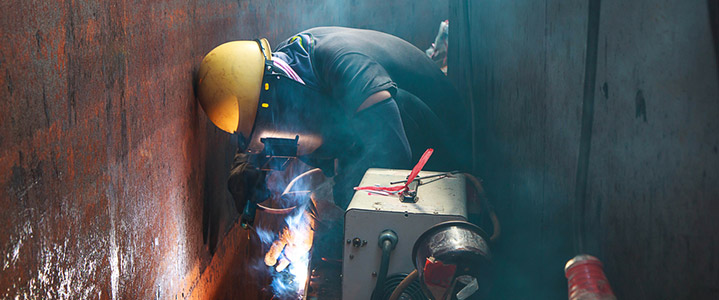On Friday, January 24, 2020, at 4:20 AM local time, an electrical spark triggered an explosion in west Houston. So, what happened? It’s reported that this spark ignited a propylene gas leak at Watson Grinding and Manufacturing. It’s still a developing story. A final report is expected sometime in April of this year.
The toxic blast killed two Watson employees. Further, it damaged 450 structures, including neighborhood homes. Windows were blown out, and families found loved ones under collapsed walls and ceilings. Overwhelmed by costs in damages and lawsuits, Watson Grinding and Manufacturing has laid off 80 workers and filed for bankruptcy.
It’s understood that it will take years to make this situation right for many affected. For some, nothing can replace the loss.
Today on the blog, we’ll look at the propylene leak itself and how this entire disaster might have been avoided. Proper MSDS and safety compliance are underlying factors.
What Caused the Houston Warehouse Explosion?
Reports right now state a spark ignited propylene gas. Propylene fuel is extremely flammable. The investigators with the Bureau of Alcohol, Tobacco, Firearms, and Explosives (ATF) predict the Watson tank leak began up to 28 hours before the blast was reported. An electrical system ignition most likely caused the explosion.
What Is Propylene?
Propylene is a gas that is colorless, but it isn’t odorless. In fact, it has a distinct sweet smell like propane. But the excellent performance of the combustion of propylene makes it the better option. Propylene is the more stable gas when it comes to heating and cutting.
Is Propylene Hazardous Material?
In short, yes. Propylene is a hazardous material. It is an extremely flammable gas. The cylinders contain gas under pressure. It may explode if heated. Further, it may form explosive mixtures with the air. The gas can also displace oxygen, causing suffocation.
Propylene Storage and Handling
The Propylene SDS (Safety Data Sheet) should be read and followed. These precautionary statements are outlined on the sheets. For a more comprehensive review, refer to examples of flammable liquid storage and handling tips in the next section.
- Keep away from heat, sparks, open flames, ignition sources, and hot surfaces.
- No smoking.
- Read the label before use and when seeking related medical advice.
- Use proper/compatible equipment rated for the cylinder pressure.
- Close valve after every use and when empty.
- Keep the cylinder or container in an upright position.
- Store in a well-ventilated area away from sunlight.
- Approach suspected leaks with caution.
Propylene MSDS
A thorough material safety data sheet for polypropylene should contain the following sections. Your company’s Propylene MSDS is in place to inform and protect. This helps make the workplace safe: workers understand risk assessment. The sheets provide workers with appropriate protection measures and even training.
You’ll find sixteen sections in these safety data sheets:
- Chemical identification
- Hazard identification
- Ingredient info
- First-aid measures
- Fire-fighting measures
- Accidental release measures
- Handling and storage
- Personal protection
- Physical/chemical properties
- Stability/reactivity
- Toxicological info
- Ecological info
- Disposal considerations
- Transport info
- Regulatory info
- Other info
The SDS provides clear information about factors like propylene flash point, vapor pressure, conditions to avoid, and so much more. For specific examples, see these SDS’s from Airgas, Praxair, and Air Liquide. You’ll note all sixteen sections are accounted for and detailed.

Propylene Dangers
Propylene danger is real. The Watson Grinding and Manufacturing incident is proof. Here is a list of propylene dangers and measures to be taken. This information is included on propylene SDS sheets.
Inhalation or Skin/Eye Contact
The inhalation of propylene can make breathing difficult and even cause it to stop altogether. In its liquid state, skin contact may result in frostbite. In the case of eye contact, immediate medical attention is required. Complete body and respiratory protection should be based on exposure levels.
Accidental Release
The release of propylene can be fatal, as the gas displaces air and can cause suffocation. Accumulation is dangerous. To maintain confined space safety, it’s important that the fuel does not enter areas like sewers, basements, work pits, and other unventilated spaces. In the event of an accidental release, workers should evacuate the area.
Fire
If this extremely flammable gas is venting or leaking, it may catch fire. Flammable vapors may spread, creating an explosive reignition hazard. Sparks, heaters, electrical equipment, smoke, pilot lights, open flames, and even static discharges may give way to an explosive atmosphere. Always check work environments with appropriate devices before entering.
Contact Safety by Design for Safety Compliance Services
Don’t wait. These aspects of your company should be a top priority. We’ve made it our career to help you avoid fatal accidents and expensive fines. It’s the mission of our safety consultants to see that disasters like January 24th never happen.
In the wake of recent events, the topic of safety risk assessment is definitely on your mind. Contact Safety by Design today to help ensure your workplace and workforce are protected. We design, educate, train, organize, and strategize your workplace safety. With us, you’ll meet with years of experience. Our expertise will serve you, your employees, and your work environment well.



